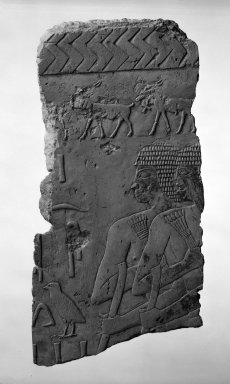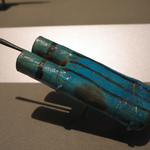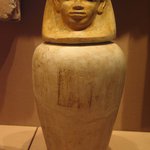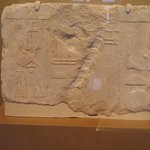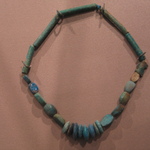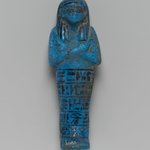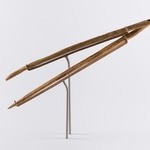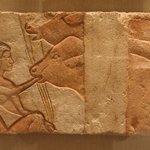

Attendants of Hatshepsut, ca. 1478–1458 B.C.E. Limestone, pigment, 11 13/16 x 5 7/8 x 1 9/16 in. (30 x 15 x 4 cm). Brooklyn Museum, Charles Edwin Wilbour Fund, 74.98.2. Creative Commons-BY (Photo: Brooklyn Museum, 74.98.2_negA_bw_IMLS.jpg)
Attendants of Hatshepsut
Egyptian, Classical, Ancient Near Eastern Art
On View: Egyptian Orientation Gallery, 3rd Floor
The zigzag pattern on the band at the top of this fragment represents water. The original scene showed a religious procession of boats carrying statues of gods and kings. The two men depicted in this fragment were part of a long line of priests and royal attendants who accompanied the flotilla on the bank of the river or canal, each carrying a long staff and a small bouquet. The regular celebration of processions such as the one depicted here reinforced the Egyptians’ idea of cyclical time and the eternal repetition of events.
MEDIUM
Limestone, pigment
DATES
ca. 1478–1458 B.C.E.
DYNASTY
Dynasty 18
PERIOD
New Kingdom
DIMENSIONS
11 13/16 x 5 7/8 x 1 9/16 in. (30 x 15 x 4 cm) (show scale)



COLLECTIONS
Egyptian, Classical, Ancient Near Eastern Art
ACCESSION NUMBER
74.98.2
CREDIT LINE
Charles Edwin Wilbour Fund
CATALOGUE DESCRIPTION
A limestone slab with representations carved in low relief. Two goats with ankh signs around their necks are in the top register. In the center are two men with arms to chests and holding floral bouquets. Below are two arms holding staves. At upper edge is a river. Before the men is a column of inscription.
Condition: Traces of red paint. Broken across lower third at left corner and across center and restored. Some nicks on surface.
EXHIBITIONS
MUSEUM LOCATION
This item is on view in Egyptian Orientation Gallery, 3rd Floor
CAPTION
Attendants of Hatshepsut, ca. 1478–1458 B.C.E. Limestone, pigment, 11 13/16 x 5 7/8 x 1 9/16 in. (30 x 15 x 4 cm). Brooklyn Museum, Charles Edwin Wilbour Fund, 74.98.2. Creative Commons-BY (Photo: Brooklyn Museum, 74.98.2_negA_bw_IMLS.jpg)
IMAGE
overall, 74.98.2_negA_bw_IMLS.jpg. Brooklyn Museum photograph
"CUR" at the beginning of an image file name means that the image was created by a curatorial staff member. These study images may be digital point-and-shoot photographs, when we don\'t yet have high-quality studio photography, or they may be scans of older negatives, slides, or photographic prints, providing historical documentation of the object.
RIGHTS STATEMENT
Creative Commons-BY
You may download and use Brooklyn Museum images of this three-dimensional work in accordance with a Creative Commons license. Fair use, as understood under the United States Copyright Act, may also apply.
Please include caption information from this page and credit the Brooklyn Museum. If you need a high resolution file, please fill out our online application form (charges apply).
For further information about copyright, we recommend resources at the United States Library of Congress, Cornell University, Copyright and Cultural Institutions: Guidelines for U.S. Libraries, Archives, and Museums, and Copyright Watch.
For more information about the Museum's rights project, including how rights types are assigned, please see our blog posts on copyright.
If you have any information regarding this work and rights to it, please contact copyright@brooklynmuseum.org.
RECORD COMPLETENESS
Not every record you will find here is complete. More information is available for some works than for others, and some entries have been updated more recently. Records are frequently reviewed and revised, and we welcome any additional information you might have.
